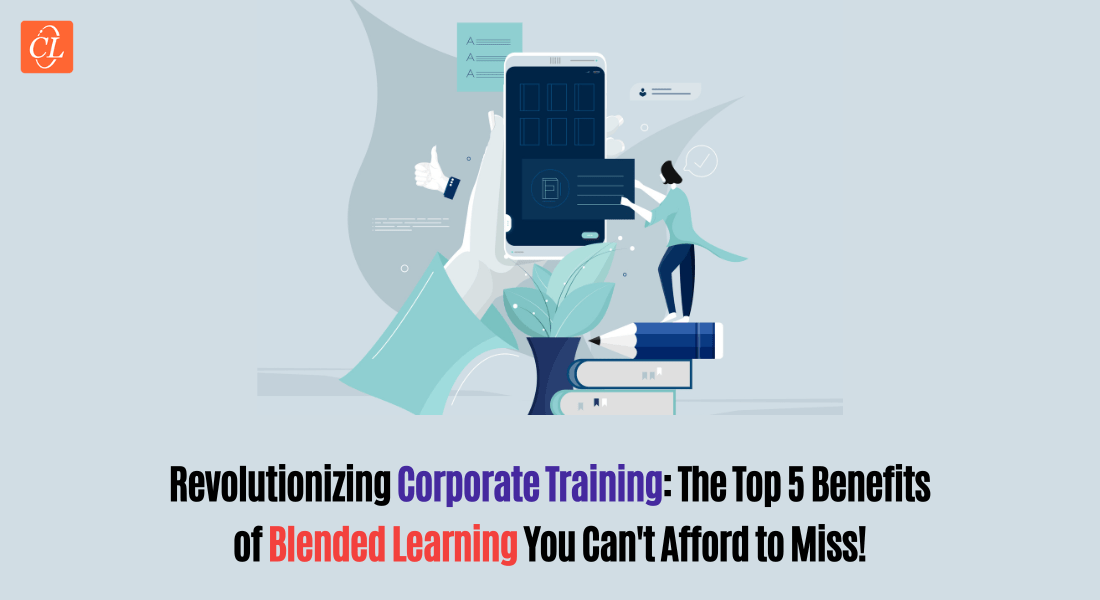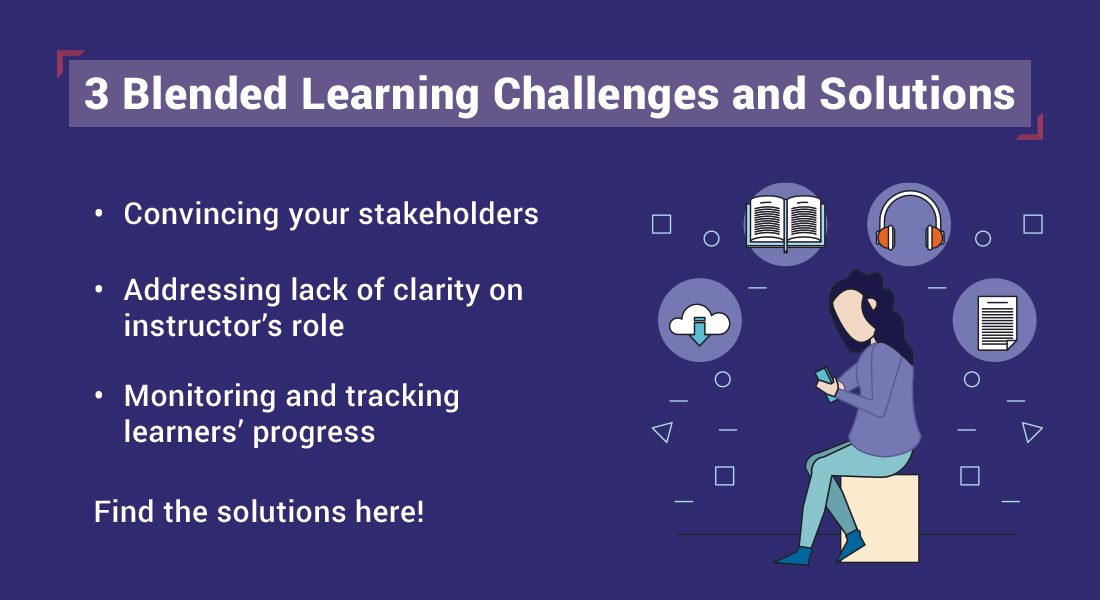Top 5 Ways Blended Learning Benefits Corporate Training
Do you often hear your employees say that they want to learn at their own pace but would prefer to discuss their doubts in-person? Well, blended learning can help. Read on to know the top 5 benefits of blended learning in corporate training.

Blended learning is the perfect mix of tradition and innovation. It combines the best of both online and in-person learning, creating an engaging and interactive learning experience that can be tailored to the unique needs of the learner. With blended learning, learners have the freedom to learn at their own pace and in the way that best suits them. Whether they prefer to learn through online resources and tools or in-person interactions, blended learning offers something for everyone.
It’s Time To Blend it Up: The Perfect Mix of Online and Offline Learning!
Given below are the top 5 benefits supporting why you should opt for blended learning:
- Facilitates personalization
- Promotes active learning
- Enables flexibility
- Offers scope for collaboration
- Incorporates continual assessment
It’s a revolutionary approach to corporate training that is changing the way we think about learning, that’s why it’s no surprise that is gaining so much popularity. Blended learning offers a perfect option where the learners are engaged, challenged, and empowered in their journey of learning and improving themselves. Blended learning opens a new world of opportunities and possibilities where the learners get to enjoy the best of both driver and passenger seat during their learning ride and the results are nothing short of inspiring.
So why keep waiting? Let’s begin.
Top 5 Ways Blended Learning Benefits Corporate Training
Blended learning is quickly becoming one of the most popular approaches to corporate training, as it offers the best of both online and classroom learning. In this section, we’ll explore top five benefits of blended learning that can help ensure your employees get the most out of their training.
Facilitates Personalization
One of the biggest advantages of blended learning is the ability to personalize the learning experience for your employees. By leveraging online resources and tools, you can provide learners with the opportunity to learn at their own pace and in the way that best suits their needs.
In blended learning, learners have access to a wide variety of online resources and tools, such as videos, interactive activities, and eBooks, which they can use to acquire new knowledge and skills at their own pace. This means that learners can work through the material at a speed that is comfortable for them, and can revisit difficult concepts as many times as they need to in order to fully understand them.
Boost your employee proficiency with blended learning! Here’s how.
To add to this, personalization also enables for differentiated instruction, where the facilitator or trainer can provide different levels of instruction, activities, and assessments to meet the diverse learning needs of the learners. It can be achieved by incorporating online assessments, such as quizzes or formative assessments, to determine employees’ understanding and progress, and then providing customized instruction accordingly.
Promotes Active Learning
Another key benefit of blended learning is that facilitates active learning. It allows learners to engage with the training material in a way that is interactive and hands-on, rather than just passively receiving information. In traditional classroom training, employees often sit passively and listen to lectures, however, in blended learning, they are encouraged to engage with the material in a more immersive and meaningful way. This can be achieved by incorporating interactive activities, such as quizzes, discussions, and group projects. Furthermore, you can also leverage a variety of other techniques such as videos, breakout rooms, teach-me-back methodology, and simulations.
These activities enable learners to pay attention and apply the knowledge they have acquired and to think critically about the information they have acquired. This can lead to increased engagement, motivation, and ultimately better learning outcomes making blended learning a preferred choice among the training experts.
Enables Flexibility
In blended learning, flexibility is crucial and a standout attribute. Flexibility refers to the element of providing learners with the freedom to learn when and where they want, whether that’s online or in-person. Since blended learning combines both synchronous and asynchronous learning formats, it aids the employees to take advantage of the resources and tools that best suit their learning style.
In a blended learning, learners can attend traditional in-person classes, but as mentioned before, they also have access to online resources, such as videos, audio, infographics, SlideShares, and eBooks, that they can use to supplement the acquired knowledge. Such flexibility also benefits employees who have other commitments such as tight work deadlines or family, who may find it difficult to attend solely the conventional instructor-led training (ILT).
Offers Scope for Collaboration
Collaboration is an important aspect of blended learning, as it enables learners and instructors to work together, share ideas, and learn from one another. Some of the well-known online platforms that foster collaboration include Google Meet, Zoom, etc. You can use these tools to facilitate group activities, conduct polls, and initiate online discussions. Collaboration can take many forms, such as instructor-learner collab or peer-to-peer collaboration and it can be done both synchronously and asynchronously.
Online discussions, which can be conducted through forums, chat rooms, or video conferencing, allow learners to collaborate and share their ideas with their peers. This can help to boost a sense of community and belonging, as well as promote critical thinking and problem-solving skills. On the other hand, group projects help in promoting teamwork, coordination, and cooperation among employees.
Incorporates Continual Assessment
Training without some measurable results is like not knowing how much water can a water bottle contain. Basically, it’s futile. Therefore, it is really important to continually assess the progress and understanding of the learners. And blended learning ensures that by offering a variety of assessment methods, such as quizzes, tests, worksheets, projects, etc., that make sure the learners are on track and understand the material.
This provides a great chance for instructors to analyze the outcome and modify their training style and strategy to ensure maximum training ROI. Formative assessment is popular assessment methodology that refers to evaluation as an ongoing process and allows facilitators to monitor employee learning and make adjustments to instruction as needed. This can include techniques such as observations, one-on-one conferences, and think-alouds. Based on the assessment analysis, trainers can share their feedback with the learners and guide them to do better in their respective fields.
Wrapping It Up!
Blended learning is a powerful and flexible approach to corporate training that offers numerous benefits to both learners and instructors. Through the combination of online and offline learning, blended learning provides learners with more personalized and active learning experiences that are engaging and effective. The integration of technology-enhanced learning activities and the use of collaboration and continual assessment help to create a dynamic and supportive learning environment for the employees. So what are you waiting for? Try it out! If you need some assistance in connecting the dots, here’s our eBook to help you out. Know all about blended learning and boost your employee performance easily! Check the eBook right away!





